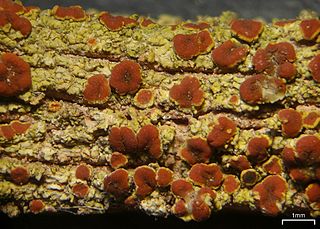
Gyalolechia is a genus of lichen-forming fungi belonging to the family Teloschistaceae. It contains 18 species of crustose lichens.
Sirenophila is a genus of crustose lichens in the subfamily Teloschistoideae of the family Teloschistaceae. It has four species with an Australasian distribution.
Huneckia is a genus of crustose lichens in the subfamily Caloplacoideae of the family Teloschistaceae. It has four species.

Tomnashia is a genus of lichen-forming fungi in the family Teloschistaceae. It has four species of saxicolous (rock-dwelling), crustose lichens that occur in southwestern North America.
Teuvoahtiana is a genus of lichen-forming fungi in the family Teloschistaceae. It contains three species of saxicolous (rock-dwelling), crustose lichens, all of which occur in South America.

Opeltia is a genus of lichen-forming fungi in the family Teloschistaceae. It has four species of corticolous (bark-dwelling), crustose lichens.
Fauriea is a genus of lichen-forming fungi in the family Teloschistaceae. The genus, which contains seven species, is a member of the subfamily Caloplacoideae.
Marchantiana is a genus of lichen-forming fungi in the family Teloschistaceae. It contains seven species of corticolous (bark-dwelling), crustose lichens that occur in the Southern Hemisphere.
Eilifdahlia is a genus of lichen-forming fungi in the family Teloschistaceae. It contains three species of corticolous (bark-dwelling), crustose lichens that occur in the Southern Hemisphere.
Franwilsia is a genus of lichen-forming fungi in the family Teloschistaceae. It has three species.
Elixjohnia bermaguiana is a species of saxicolous (rock-dwelling), crustose lichen in the family Teloschistaceae. It is found in Australia. The lichen is characterised by its varying areoles, which are thin to moderately thick, flat to slightly convex, and range from bright yellow to whitish in colour, sometimes with a greenish-yellow hue. Its apothecia are small, with a distinct orange margin and a raised brownish-orange or yellowish-brown disc.
Gintarasiella is a single-species genus in the fungal family Teloschistaceae. It contains the species Gintarasiella aggregata, a saxicolous (rock-dwelling), crustose lichen that is found in Australia. The lichen forms uneven, pillow-like patches up to 30 mm across, distinguished by its yellow-orange areoles that are tightly packed or spread out and soon covered by many apothecia. These fruiting bodies start as zeorine in form and later become biatorine, ranging from 0.3 to 1 mm wide and often appearing distorted due to their dense clustering.
Caloplaca nothoholocarpa is a species of saxicolous (rock-dwelling), crustose lichen in the family Teloschistaceae. It is found in Chile.
Oxneriopsis is a genus of lichen-forming fungi in the family Teloschistaceae. It has four species of corticolous (bark-dwelling), crustose lichens.
Lazarenkoiopsis is a single-species fungal genus in the family Teloschistaceae. It contains Lazarenkoiopsis ussuriensis, a corticolous (bark-dwelling), crustose lichen species found in the Russian Far East.
Elixjohnia jackelixii is a species of saxicolous (rock-dwelling), crustose lichen in the family Teloschistaceae. It is found in Australia and New Zealand. The lichen is characterised by its unique multilayered appearance with outer sterile rings that are brownish or greenish-yellow and inner areoles that are whitish, yellowish, or greyish, often cracked to reveal the medulla underneath. Its fruiting bodies, or apothecia, are typically attached directly to the thallus and vary in colour and shape.
Loekoesia is a genus of lichen-forming fungi in the family Teloschistaceae. It contains three species of saxicolous (rock-dwelling), crustose lichens. Collectively, the genus occurs in South Korea, Mauritius, and the United States. The genus is distinguished by its grey, crust-like thallus, which can be either whole or divided into patch-like segments. Loekoesia lichens have bright white, rounded soralia, which produce bluish to whitish powdery propagules (soredia) and are arranged in irregular groups on the thallus.
Nevilleiella is a genus of lichen-forming fungi in the subfamily Teloschistoideae of the family Teloschistaceae. It has two species of crustose lichens that are found in Australia.
Nevilleiella marchantii is a species of terricolous (ground-dwelling), crustose lichen in the family Teloschistaceae. Found in Australia, it was formally described as a new species in 2007. The thallus of Nevilleiella marchantii spreads 1–3 cm wide, with distinctive, almost spherical, pustule-like formations that give it an appearance resembling a bunch of grapes. These formations vary in shape and colour from yellow-brown to orange-brown.
Marchantiana occidentalis is a species of corticolous and saxicolous, crustose lichen in the family Teloschistaceae. It is found in Western Australia, usually as an inhabitant of dry twigs, bark, or wood of various plant species, but occasionally on granite rock outcrops. It forms a well-developed thallus, shiny and composed of tiny dark greenish to brown areoles, with sizes typically ranging from 5–15 mm, though larger aggregations are possible. It features numerous rounded apothecia scattered across its surface, varying in form and colour, with a distinct margin and disc.


